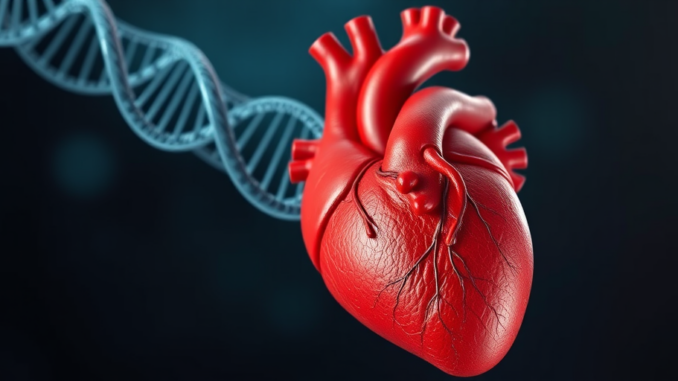
Summary
Researchers have linked gene duplications and deletions within a specific chromosome region to nonsyndromic bicuspid aortic valve disease, paving the way for better risk assessment and potential future treatments. This discovery sheds light on the genetic underpinnings of this common congenital heart defect, offering hope for improved patient outcomes. The study identified these genetic variations in a significant percentage of early-onset cases, highlighting the importance of further investigation.
Secure patient data with ease. See how TrueNAS offers self-healing data protection.
Main Story
Okay, let’s talk about Bicuspid Aortic Valve disease, or BAV as it’s often called. It’s actually the most common congenital heart defect, and it affects, get this, up to 2% of the population. That’s a pretty significant number. Basically, instead of having the usual three leaflets in your aortic valve, you’ve got two. Sounds like a small thing, but trust me it can lead to pretty major issues like aortic aneurysms, valve narrowing, and weakened aortic walls.
For ages, it’s been a real head-scratcher for researchers; figuring out the underlying causes and how to best manage it. But now, there’s a really interesting study out of UTHealth Houston, published in Heart, that’s shedding some light on the genetic side of things. They’ve found a significant link between BAV and large, rare duplications or deletions in a specific part of chromosome 22, which is super important for heart development.
This specific study found that these types of rare genetic variations were present in around 7.4% of people who developed BAV at an early age, which you’ve got to admit, is quite a significant finding. It really highlights how variations in chromosome 22 can impact the severity and the risks associated with the condition, and we’re not talking about some minor change, either. We’re talking about large, structural genetic variations. It’s termed ‘nonsyndromic’ when it occurs in isolation, not part of another condition.
Now, what’s interesting is, we’ve known that BAV can be inherited through multiple gene mutations, but the exact mechanisms have always been sort of blurry. Past research has touched on how genomic duplications or deletions impact heart development, but this research really zeroes in on chromosome 22 and its role in BAV; and its not an insignificant role either. This new data could really change how we think about risk assessment and the way we manage BAV. It’s also a huge step forward in personalized medicine for these patients.
Frankly, identifying the specific genetic variations could transform the field. Imagine more accurate diagnostic tests and treatments tailored to each individual’s genetic profile. It’s exciting, right?
Think about the long-term impact. This could be the foundation for targeted therapies that fix, or at least reduce the impact of these genetic variations. That could potentially prevent complications, or delay them significantly. This will be a game changer if it proves to be effective. In a way its like finding the key in a lock, that’s been unopenable.
Let’s switch gears a little bit and talk more generally about BAV itself. The aortic valve controls blood flow from your heart to the rest of your body, and those leaflets (the cusps) normally open and close with each heartbeat to ensure blood goes in the right direction. But with BAV, that’s not always the case, and blood can leak backwards, causing aortic regurgitation, or the valve itself can be too tight, restricting blood flow, which we call aortic stenosis.
You can imagine, that this can lead to a range of symptoms; things like shortness of breath, chest pain, feeling completely exhausted, and dizziness. Some people with BAV live their whole lives without knowing they even have it but, on the other hand, some can get progressively worse and require serious medical intervention.
The advances made in pediatric cardiology have really helped patients suffering from BAV. The innovations in diagnostic imaging, surgical techniques and genetic testing have transformed how we detect, manage, and treat children with congenital heart defects. And honestly, that is the most important thing. We’re talking about children’s hearts here. Early diagnosis and intervention are, of course, crucial in preventing long-term issues for these young patients, and research like this genetic study holds so much promise for improving how we care for them moving forward.
In conclusion, this is a breakthrough and will hopefully improve the outlook for many individuals and their families. The potential to develop targeted therapies is truly ground-breaking and it’ll be interesting to see where the research leads over the next few years.


So, a wonky valve is down to a chromosome party mishap? Sounds like some serious genetic karaoke gone wrong. Hope they find a way to get those duplications and deletions in tune!
That’s a great way to put it! ‘Genetic karaoke gone wrong’ really captures the essence of these complex duplications and deletions. It’s amazing to think how these variations impact heart development, and hopefully we’ll see progress on treatments in the near future.
Editor: MedTechNews.Uk
Thank you to our Sponsor Esdebe – https://esdebe.com
So, 7.4% of early-onset cases, you say? Does that mean the other 92.6% are just winging it with three valves? I wonder how their chromosome 22 is spending its downtime.
That’s a great question! It’s fascinating to consider what factors might be at play for the other 92.6%. It could be a combination of other genetic influences, environmental factors, or even how the chromosome 22 variations present at different stages of development. More research is definitely needed!
Editor: MedTechNews.Uk
Thank you to our Sponsor Esdebe – https://esdebe.com